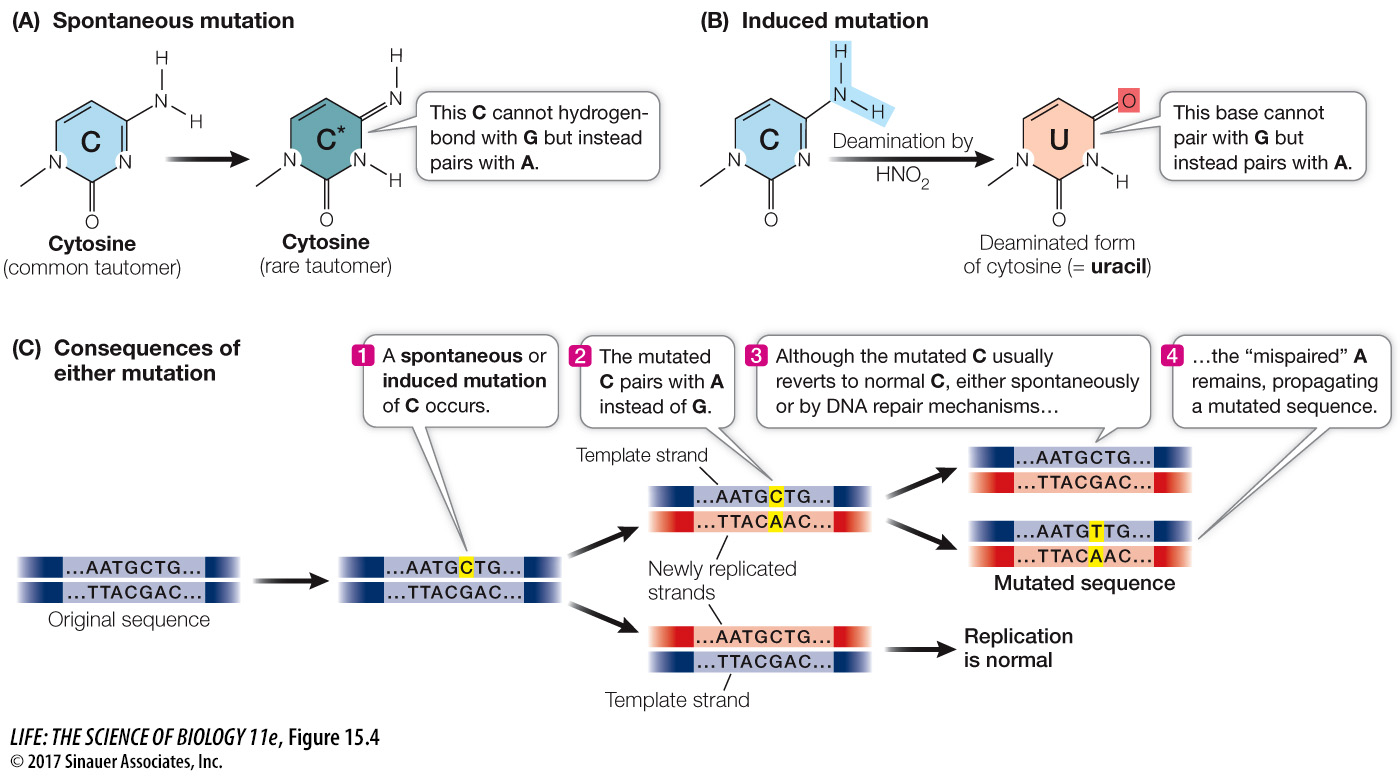Mutations can be spontaneous or induced
It is useful to distinguish between mutations that are spontaneous or induced, based on their causes. Spontaneous mutations are permanent changes in the genetic material that occur without any outside influence. The movement of transposons is an example of spontaneous mutation. Spontaneous mutations can also occur because cellular processes are imperfect, and may occur by several mechanisms:
A transient rearrangement in the structure of a nucleotide base can result in mistakes during replication. Each base can exist in two different forms (called tautomers), one of which is common and one rare. When a base temporarily forms its rare tautomer, it can pair with the wrong base. For example, C normally pairs with G, but if C takes on the form of its rare tautomer at the time of DNA replication, it pairs with (and DNA polymerase will insert) an A. If this is passed on to a daughter cell after cell division, the result is a point mutation: G → A (Figure 15.4A and C).
A chemical reaction may alter the structure of a DNA base. For example, a deamination reaction can result in loss of the amino group (NH2) attached to carbon 4 in cytosine. If this occurs in a DNA molecule, the error will usually be repaired. However, since the repair mechanism is not perfect, the altered nucleotide will sometimes remain during replication. In these cases, DNA polymerase will add an A (which base-
pairs with U on the template DNA) instead of G (which normally pairs with C). DNA polymerase can make errors in replication (see Key Concept 13.4)—for example, by inserting a T opposite a G. Most of these errors are repaired by the proofreading function of the replication complex, but some errors escape detection and become permanent.
Meiosis is not perfect. Nondisjunction—
the failure of homologous chromosomes to separate during meiosis— can occur, leading to one too many chromosomes or one too few (see Figure 11.19). Random chromosome breakage and rejoining can produce deletions, duplications, inversions, or translocations.

Induced mutations occur when some agent from outside the cell—
Some chemicals can alter nucleotide bases. For example, nitrous acid (HNO2) and similar molecules can react with cytosine and convert it to uracil by deamination. More specifically, they convert an amino group on the cytosine (—NH2) into a keto group (—C=O) (Figure 15.4B). This alteration has the same result as spontaneous deamination: instead of a G, DNA polymerase inserts an A (see Figure 15.4C).
318
Some chemicals add groups to the bases. For instance, benzopyrene, a component of cigarette smoke, adds a large chemical group to guanine, making it unavailable for base pairing. When DNA polymerase reaches such a modified guanine, it inserts any one of the four bases at random. Three-
fourths of the time the inserted base is not cytosine, and a mutation results. Radiation damages the genetic material. Radiation can damage DNA in two ways. First, ionizing radiation (including X rays, gamma rays, and radiation from unstable isotopes) produces highly reactive chemicals called free radicals. Free radicals can change bases in DNA to forms that are not recognized by DNA polymerase. Ionizing radiation can also break the sugar–
phosphate backbone of DNA, causing chromosomal abnormalities. Second, ultraviolet radiation (from the sun or a tanning lamp) is absorbed by thymine, causing it to form covalent bonds with adjacent bases. This, too, plays havoc with DNA replication by distorting the double helix.